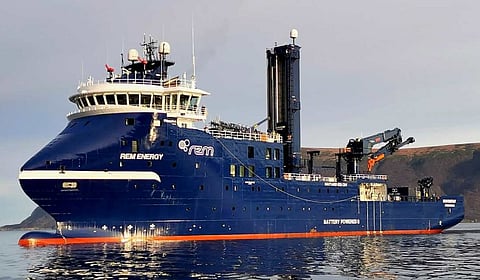

Norway's Rem Offshore has begun operating a recently completed construction support vessel (CSV) that is designed primarily to support the activities of customers in the offshore renewables sector.
The DNV-classed, Havyard-designed Rem Energy was originally built as a platform supply vessel (PSV) for a different owner and was to be named Atlantic Harrier. Construction on the PSV was well underway when the unfinished hull was transported from another shipyard to Green Yard Kleven (GYK) in Ulsteinvik, Norway, for completion. The vessel was also re-designed to be optimised for offshore wind construction and walk-to-work operations rather than the platform supply role.
Rem Energy has an LOA of 90.7 metres, a beam of 19.74 metres, and a draught of 5.9 metres. Conference areas and berths for 99 personnel are also available, making the vessel ideal for operating as an accommodation platform in addition to providing offshore construction and maintenance support. All interior spaces were designed by Vestnes Ocean and are kept comfortable with the aid of a complete HVAC system from AF AeronMollier. The vessel also has toilets from Jets and a UV treatment system from Filtra.
The batteries have a total output of 12 MW and are designed to be charged either through a shore connection or through the onboard diesel generators. The batteries supply power for the engines, which in turn drive a set of Steerprop azimuth thrusters. The Caterpillar main and auxiliary engines, which are also fitted with selective catalytic reduction systems, were provided by Pon Power. To provide added manoeuvrability during berthing/unberthing, station keeping, and sailing in close quarters, the vessel relies on tunnel thrusters and retractable thrusters from Brunvoll.
The vessel was designed to allow future modifications to the propulsion system as newer technologies such as hydrogen propulsion and fuel cells become available to further reduce emissions. It may also accommodate additional battery packs if required.
To ensure proper station keeping when working on wind turbines, Rem Energy utilises a dynamic positioning system supplied by Kongsberg, which also provided the vessel's gyrocompass and joystick control system. Kongsberg also supplied its proprietary infrastructure service, which will enable Rem Offshore to collect data from the CSV and enable the use of applications to optimise operations. One application supports fuel consumption and emissions reduction, as well as automates reporting processes, while the other application is an advanced decision support tool.
A Norwegian Electric Systems package meanwhile includes bridge and engine room consoles, switchboards, radar, GPS, an autopilot, and UHF and VHF radios. The onboard electric actuators were supplied by Eltorque.
Equipment includes an SMST package consisting of an access tower with lift, a motion compensated gangway, and a 3D motion compensated crane. Also fitted are a Bergen Hydraulic crane on the aft and gangways from Gurskoy. The safety equipment meanwhile includes Mare Safety lifeboats with davits and firefighting gear from Survitec.
The searchlights and navigation lights are from R. Stahl Tranberg while Libra Plast and Jotun paints were used on the exteriors. The array of deck machinery includes an anchor and chains from Fossen Shipping, Adria Winch mooring winches and capstans, and Varde rope drums.
Rem Energy has already commenced its first charter as part of the Rem Offshore fleet. It is presently deployed in support of Siemens Gamesa Renewable Energy under a long-term contract for maintenance at various wind farms off the northern coast of Germany.
| Rem Energy | |
| SPECIFICATIONS | |
| Type of vessel: | Construction support vessel |
| Classification: | DNV |
| Flag: | Norway |
| Owner: | Rem Offshore, Norway |
| Designer: | Havyard Design and Solutions, Norway |
| Builder: | Green Yard Kleven, Norway |
| Length overall: | 90.7 metres |
| Beam: | 19.74 metres |
| Draught: | 5.9 metres |
| Main engines: | Caterpillar |
| Propulsion: | Steerprop azimuth thrusters |
| Auxiliary engines: | Caterpillar |
| Side thrusters: | Brunvoll |
| Batteries: | 12 MW |
| Electronics supplied by: | Norwegian Electric Systems |
| Dynamic positioning: | Kongsberg |
| Radios: | UHF; VHF |
| Compass: | Kongsberg |
| Other electronics: | Kongsberg joystick control system; Kongsberg infrastructure service; Eltorque electric actuators |
| Winches: | Adria Winch |
| Capstan: | Adria Winch |
| Cranes: | SMST; Bergen Hydraulic |
| Anchor: | Fossen Shipping |
| Other deck equipment: | Fossen Shipping chains; Varde rope drums |
| Other equipment installed: | AF AeronMollier HVAC; Jets toilets; Filtra UV treatment system; Pon Power SCR; SMST access tower; SMST gangway; Gurskoy gangways |
| Paints/coatings: | Libra Plast; Jotun |
| External lighting: | R. Stahl Tranberg |
| Interior designer: | Vestnes Ocean |
| Firefighting equipment: | Survitec |
| Lifeboats: | Mare Safety |
| Accommodation: | Conference areas |
| Passengers: | 99 |
